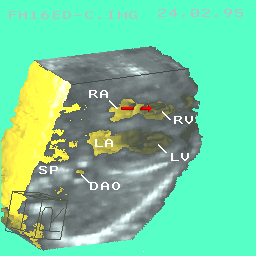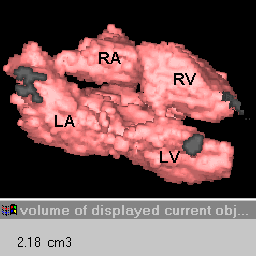| Read
Display
Info if you have difficulty browsing these graphics-orientated pages. |
To view a movie, click on an image with a [GIF] or [AVI]
link) |
 |
 |
| A dynamic 3D (4D) cardiac movie from a 19- week fetus
[GIF
744 KB] [AVI 57 KB]. SP: spine. |
Negative display of the chambers of the same heart. It
makes it convenient to measure the cardiac volumes of irregular shapes. |
![[.gif 38kb]](usmedb6a.gif) |
| Interactive multiplanar reformatting of the
3D object [(o)s in upper & lower sets] with different orientations
providing unlimited sets of three orthogonal 2D planes using only one scan
data set. Only shown here are - Upper: (a) left ventricular short axis
view; (b) left heart two-chamber view; and (c) 4-chamber view. Lower: (a)
long axis view of left heart, (b) cardiac base short axis view, and (c)
bi-ventricular view. The positions of the planes (a), (b) and (c) were
indicated by section lines a,b,c. AO: aorta; PA: pulmonary artery; RVOT:
right ventricular outflow tract. |
![[.gif 41kb]](usmedb6b.gif) |


![[.gif 38kb]](usmedb6a.gif)
![[.gif 41kb]](usmedb6b.gif)
